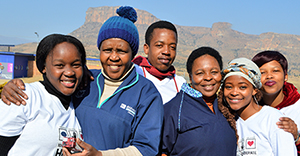
Participants in the Kindness Project sharing a
Random Act of Kindness with the cleaning staff,
Mathabiso Sehlabaka and Madineo Mokoena.
Photo: Thabo Kessah
Various studies have reported that the cultivation and practice of compassion may result in improved self-esteem, a decrease in depression and anxiety, increase in subjective well-being, and overall improvement in physical and psychological health. This is according to Counselling Psychologist, Tobias van den Bergh, during the Kindness Project (KP) on the Qwaqwa Campus.
“Students that are involved in this project have shown statistically significant improvements in overall well-being and compassion towards themselves and others,” said Van den Bergh, the project leader and Head of Department: Student Counselling and Development, Qwaqwa Campus.
“In addition, student participants of the compassion-based intervention showed a decrease in their experience of debilitating emotions and depressive symptoms, as well as a significant increase in measurements of positive affect (an indication of life vitality), self-compassion, and well-being. Humans appear to be genetically programmed to be kind. Studies have shown that the same brain structures that are activated when we procreate (i.e. have sex) or eat chocolates, are activated when we are kind. Thus, it means showing an instinctive predisposition towards compassion for our kin and others. Kindness also appears to be contagious. Whenever we observe kindness or experience kindness ourselves, we are much more likely to be compassionate towards our fellow human beings,” he said.
The KP is based on the Science of Compassion, with participants completing a four-week compassion-based intervention where they learned about and practised self-compassion and compassion towards others. In the last week of the programme, participants completed various Random Acts of Kindness off and on the campus.